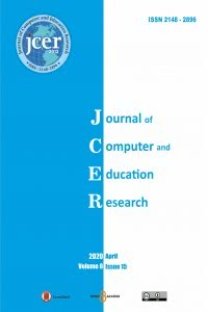Mathematics Teachers’ Views on Mathematical Thinking
Mathematical thinking, teacher training, content analysis
Mathematics Teachers’ Views on Mathematical Thinking
Mathematical Thinking, Teacher Training, content analysis,
___
- Aytaçlı, B. (2012). A detailed overview of the case study, Journal of Educational Sciences, 3(1), 1-9.
- Baş, S., Erbaş, A. K., Çetinkaya, B. (2011). Teachers' knowledge about algebraic thinking structures of ninth grade students, Education and Science, 36(159), 41-55.
- Carpenter, T. P., Fennema, E., Peterson, P. L., Chiang, C.& Loef, M. (1989).Using knowledge of children’s mathematics thinking in classroom teaching: An experimental study. American Educational Research Journal, 26(4), 499-531.
- Cobb, P., Wood, T., Yackel, E. (1990). Classrooms as learning environments for teachers and researchers. In R.B. Davis, C.A. Maher, & N. Noddings (Eds.), Constructivist views on the teaching and learning of mathematics (Monograph 4, pp. 125-146). Reston, VA: National Council of Teacher of Mathematics.
- Cobb, P., Wood, T., Yackel, E., Nicholls, J., Wheatley, G., Trigatti, B. & Perlwitz, M. (1991). Assessment of a problem-centered second-grade mathematics project. Journal for Research in Mathematics Education, 22(1), 3-29.
- Cooper, S. (2009). Preservice teachers’ analysis of children’s work to make instructional decisions. School Science and Mathematics, 109(6), 355-362.
- Crespo, S. (2000). Seeing more than right and wrong answers: Prospective teachers interpretations of students’ mathematical work. Journal of Mathematics Teacher Education, 3(1), 155-181.
- Crespo, S. (2003). Learning to pose mathematical problems: Exploring changes in preservice teachers’ practices. Educational Studies in Mathematics, 52(3), 243-270.Even, R. & Tirosh, D. (2008). Handbook of teacher knowledge and understanding of students’ mathematical learning and thinking international research in mathematics education (2nd Edition, 202-222).,New York: Routledge.
- Fennema, E., Carpenter, T. P., Franke, M. L., Levi, L., Jacobs, V. & Empson, S. (1996). A longitudinal study of learning to use children's thinking in mathematics instruction. Journal for Research in Mathematics Education, 27(4), 403-434.
- Fravillig, J. L., Murphy, L. A. & Fuson, K. C.(1999). Advancing children’s mathematical thin- king in everyday mathematics classrooms, Journal for Research in Mathematics Education,30(2), 148-170.
- Franke, M. L. & Kazemi, E. (2001). Learning to teach mathematics: Focus on student thinking. Theory into Practice, 40(2), 102-109.
- Franke, M. L., Carpenter, T. P., Levi, L. & Fennema, E. (2001). Capturing teachers' generative change: a follow-up study of professional development in mathematics. American Educational Research Journal, 38(3), 653-689.
- Council of Higher Education. (2018). New teacher training lisance programmes. Retrieved from: http://www.yok.gov.tr/web/guest/icerik/-/journal_content/56_INSTANCE_rEHF8BIsfYRx/10279/41807946.
- Isoda, M. & Katagiri, S. (2018). Mathematical thinking: How to develop it in the classroom, Retrieved from: http://dx.doi.org/10.1142/8163.
- Liu, P. H. & Niess, M. L. (2006). An exploratory study of college students' views of mathematical thinking in a historical approach calculus course. Mathematical Thinking and Learning, 8(4), 373-406.
- McLeman, L. K. & Cavell, H. A. (2009). Teaching fractions. Teaching Children Mathematics, 15(8), 494-501.
- Moss, E. R. (2009). Preservice teachers’ identity development and participation in a video club focused on mathematical thinking. Doctor of Philosophy Dissertation, Purdue University, West Lafayette, Indiana.
- Moyer, P. S. & Milewicz, E. (2002). Learning to question: categories of questioning used by preservice teachers during diagnostic mathematics interviews. Journal of Mathematics Teacher Education, 5(1), 293-315.
- Olkun, S. & Toluk, Z. (2004).Activity based mathematics teaching in primary education (3. edition), Ankara: Anı Publishing.
- R.A. Philipp. (2008). Motivating prospective elementary school teachers to learn mathematics by focusing upon children’s mathematical thinking. Issues in Teacher Education, 17(2), 7-26.
- Shifter, D. (1998). Learning mathematics for teaching: From a teachers’ seminar to the classroom. Journal of Mathematics Teacher Education, 1(1), 55-87.
- Steinberg, R. M., Empson, S. B. & Carpenter, T. P. (2004). Inquiry into childrens’ mathematical thinking as a means to teacher change. Journal of Mathematics Teacher Education, 7(1), 237-267.
- Subaşı, M. & Okumuş, K. (2017). Case study as a research method. Atatürk University Journal of the Institute of Social Sciences, 21(2), 419-426.
- Suzuki, K. (1998). Measuring “To think mathematically”: Cognitive characterization of achievement levels in performance-based assessment. University of Illinois at Urbana-Chanpaign The Graduate College. Doctor of Philosophy.
- Tall, D. (195). Cognitive growth in elementary and advanced mathematical thinking, Proceedings of the Nineteenth International Conference for the Psychology of Mathematics Education, 61-75.
- Wallach, T. & Even, R. (2005). Hearing students: The complexity of understanding what they are saying, showing, and doing. Journal of Mathematics Teacher Education, 8(1), 393-417.
- Yin, R. K. (2003). Case study research: Design and methods (3rd ed.), Thousand Oaks, CA: Sage.
- Yayın Aralığı: 2
- Başlangıç: 2013
- Yayıncı: Tamer KUTLUCA
The Scale of Happiness Strategies for Childrens Used by Preschool Teachers
Özkan SAPSAĞLAM, Ayça Bahar BAKKALOĞLU, Ali ERYILMAZ
İlkokulda STEM: Öğrencilerin Kariyer İlgileri ve Tutumları
Ortaya Çıkan Modelleme Yaklaşımıyla Kavramlaştırma Süreci: Sembolleştirme Örneği
Phenomenon-Based Learning for Teaching ICT Subject through other Subjects in Primary Schools
Karzan WAKIL, Rupak RAHMAN, Dana HASAN, Pakhshan MAHMOOD, Trifa JALAL
An Examination of Middle School 7th Grade Students’ Mathematical Abstraction Processes
Elif KILIÇOĞLU, Abdullah KAPLAN
Teknoloji Destekli Probleme Dayalı Öğretim Uygulamalarının Matematik Başarısına Etkisi
Yücel ÇETİN, Şeref MİRASYEDİOĞLU
Ebru KÜKEY, Recep ASLANER, Tayfun TUTAK
The Scale of Happiness Strategies for Children’s used by Preschool Teachers
Özkan SAPSAĞLAM, Ali ERYILMAZ, Ayça Bahar BAKKALOĞLU
İlkokul 3. Sınıf Fen Bilimleri Ders Kitabında: Dilbilgisel Eğretileme Olarak Adlaştırma
